
The Jazz Singer is a 1927 American part-talkie musical drama film directed by Alan Crosland and produced by Warner Bros. Pictures. It is the first feature-length motion picture with both synchronized recorded music and lip-synchronous singing and speech. Its release heralded the commercial ascendance of sound films and effectively marked the end of the silent film era with the Vitaphone sound-on-disc system, featuring six songs performed by Al Jolson. Based on the 1925 play of the same title by Samson Raphaelson, the plot was adapted from his short story "The Day of Atonement".

Mary Louise Cecilia "Texas" Guinan was an American actress, producer, and entrepreneur. Born in Texas to Irish immigrant parents, Guinan decided at an early age to become an entertainer. After becoming a star on the New York stage, the repercussions of her involvement in a weight loss scam motivated her to switch careers to the film business. Spending several years in California appearing in numerous productions, she eventually formed her own company.

George Raft was an American film actor and dancer identified with portrayals of gangsters in crime melodramas of the 1930s and 1940s. A stylish leading man in dozens of movies, Raft is remembered for his gangster roles in Quick Millions (1931) with Spencer Tracy, Scarface (1932) with Paul Muni, Each Dawn I Die (1939) with James Cagney, Invisible Stripes (1939) with Humphrey Bogart, and Billy Wilder's comedy Some Like It Hot (1959) with Marilyn Monroe and Jack Lemmon; and as a dancer in Bolero (1934) with Carole Lombard and a truck driver in They Drive by Night (1940) with Ann Sheridan, Ida Lupino and Bogart.

The Singing Fool is a 1928 American sound part-talkie musical drama motion picture directed by Lloyd Bacon which was released by Warner Bros. In addition to sequences with audible dialogue or talking sequences, the film features a synchronized musical score and sound effects along with English intertitles. The soundtrack was recorded using the Vitaphone sound-on-disc system. The film stars Al Jolson and is a follow-up to his previous film, The Jazz Singer. It is credited with helping to cement the popularity of American films of both sound and the musical genre. The film entered the public domain on January 1, 2024.

Tom Tyler was an American actor known for his leading roles in low-budget Western films in the silent and sound eras, and for his portrayal of superhero Captain Marvel in the 1941 serial film The Adventures of Captain Marvel. Tyler also played Kharis in 1940's The Mummy's Hand, a popular Universal Studios monster film.

Night After Night is a 1932 American pre-Code drama film starring George Raft, Constance Cummings, and Mae West in her first movie role. Others in the cast include Wynne Gibson, Alison Skipworth, Roscoe Karns, Louis Calhern, and Bradley Page. Directed by Archie Mayo, it was adapted for the screen by Vincent Lawrence and Kathryn Scola, based on the Cosmopolitan magazine story Single Night by Louis Bromfield, with West allowed to contribute to her lines of dialogue.

Each Dawn I Die is a 1939 gangster film directed by William Keighley and starring James Cagney and George Raft. The plot involves an investigative reporter who is unjustly thrown in jail and befriends a famous gangster. The film was based on the novel of the same name by Jerome Odlum and the supporting cast features Jane Bryan, George Bancroft, Slapsie Maxie Rosenbloom, and Victor Jory.
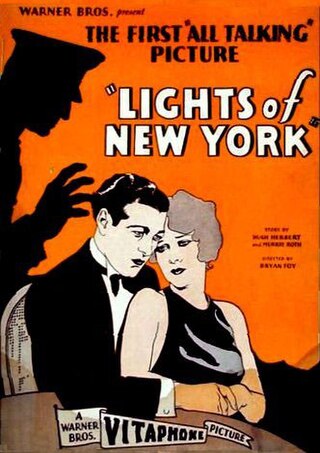
Lights of New York is a 1928 American crime drama film starring Helene Costello, Cullen Landis, Wheeler Oakman and Eugene Pallette, and directed by Bryan Foy. Filmed in the Vitaphone sound-on-disc sound system, it is the first all-talking full-length feature film, released by Warner Bros., who had introduced the first feature-length film with synchronized sound Don Juan, in 1926; and the first with spoken dialogue, The Jazz Singer, in 1927. The film, which cost $23,000 to produce, grossed over $1 million. The enthusiasm with which audiences greeted the talkies was so great that by the end of 1929, Hollywood was producing sound films exclusively.

Edwin Fitzgerald Jr., known professionally as Eddie Foy Jr., was an American stage, film and television actor. His career spanned six decades, beginning as part of the vaudeville act Eddie Foy and the Seven Little Foys.
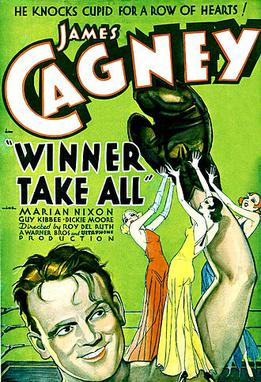
Winner Take All is a 1932 American pre-Code drama film directed by Roy Del Ruth and starring James Cagney as a boxer. The film also features a single scene of George Raft conducting a band that had been lifted from Queen of the Nightclubs, an earlier film and lost film. Cagney and Raft would not make a full-fledged film together until Each Dawn I Die seven years later.
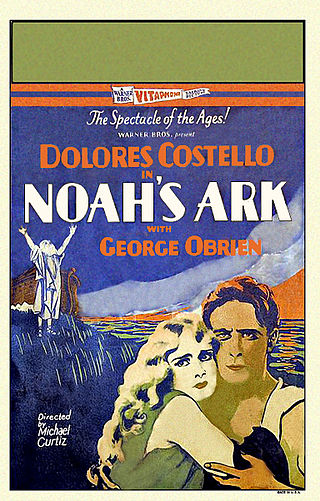
Noah's Ark is a 1928 American part-talkie epic disaster film directed by Michael Curtiz and starring Dolores Costello and George O'Brien. In addition to sequences with audible dialogue or talking sequences, the film features a synchronized musical score and sound effects along with English intertitles. The soundtrack was recorded using the Vitaphone sound-on-disc system. The story is by Darryl F. Zanuck. The film was released by the Warner Bros. studio. Most scenes are silent with a synchronized music score and sound effects, in particular the biblical ones, while some scenes have dialogue.

Say It with Songs is a 1929 American pre-Code musical drama film, directed by Lloyd Bacon and released by Warner Bros. The film stars Al Jolson and Davey Lee and was a follow-up to their previous film, The Singing Fool (1928).

Bryan Foy was an American film producer and director. He produced more than 200 films between 1924 and 1963. He also directed 41 films between 1923 and 1934. He headed the B picture unit at Warner Bros. where he was known as "the keeper of the B's".
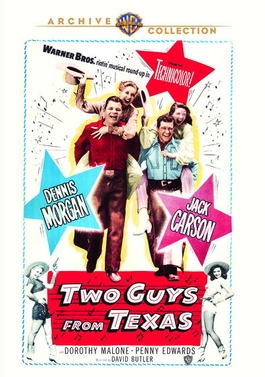
Two Guys from Texas is a 1948 American made Western-themed musical comedy film starring longtime song-and-dance partners Dennis Morgan and Jack Carson. Directed by David Butler, it was written by Allen Boretz and I.A.L. Diamond, and features Dorothy Malone and Penny Edwards in support.
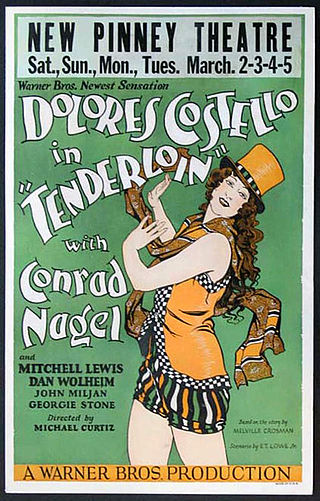
Tenderloin is a 1928 American sound part-talkie crime film directed by Michael Curtiz, and starring Dolores Costello. In addition to sequences with audible dialogue or talking sequences, the film features a synchronized musical score and sound effects, along with English intertitles. The soundtrack was recorded using the Vitaphone sound-on-disc system. It was produced and released by Warner Bros. Tenderloin is considered a lost film, with no prints currently known to exist.
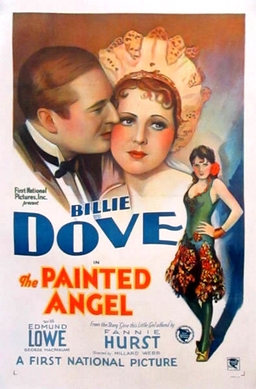
The Painted Angel is a 1929 black and white American film. The storyline is based on a story by Fannie Hurst, "Give This Little Girl a Hand" The film is known as La favorita di Broadway in Italy. The tagline was: Do you want to know the Truth about NIGHT CLUB HOSTESSES?

Broadway Through a Keyhole, also billed as Broadway Thru a Keyhole, is a 1933 American pre-Code musical film produced by Twentieth Century Pictures and released by United Artists.
An Angel from Texas is a 1940 comedy film directed by Ray Enright and written by Fred Niblo Jr. and Bertram Millhauser, based on the hit 1925 play The Butter and Egg Man written by George S. Kaufman. The film stars Eddie Albert, Rosemary Lane, Wayne Morris, Ronald Reagan and Jane Wyman. It was released by Warner Bros. on April 27, 1940.
Edwin B. DuPar was an American cinematographer, special effects technician, and film director who worked on hundreds of projects during his lengthy career in Hollywood, beginning in the early 1920s.

















